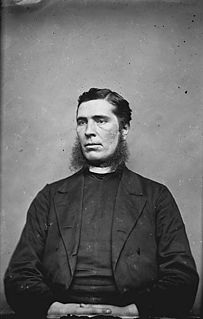
Trefriw is a village and community in Conwy County Borough, Wales. It lies on the river Crafnant in North Wales, a few miles south of the site of the Roman fort of Canovium, sited at Caerhun. At the last three censuses the population of the community has been recorded as 842 in 1999, 915 in 2001, and 783 in 2011.

The River Conwy is a river in north Wales. From its source to its discharge in Conwy Bay it is 55 kilometres (34 mi) long and drains an area of 678 square km. "Conwy" was formerly Anglicised as "Conway."

Sir John Rhys, was a Welsh scholar, fellow of the British Academy, Celticist and the first professor of Celtic at Oxford University.

Gwydir Castle is situated in the Conwy valley, Wales, a mile to the west of the ancient market town of Llanrwst and 1.5 miles (2.4 km) to the south of the large village of Trefriw. An example of a fortified manor house dating back to c1500, it is located on the edge of the floodplain of the river Conwy, and overlooked from the west by the now-forested slopes of Gwydir Forest.

Llanrhychwyn is a hamlet in Conwy county borough, Wales. It lies in the Conwy valley, less than a mile south of Trefriw, and a mile north-west of Llanrwst. Today neighbouring Trefriw is a village with a population of around 600, but in the time of Llywelyn Fawr, and up to the early 19th century, Llanrhychwyn was larger than Trefriw, which consisted simply of "a few houses here and there". Indeed, even today both Trefriw and Llanrhychwyn lie within the parish of Llanrhychwyn. The area around Llanrhychwyn had a population of only 178 in 2011.

The Cwrtmawr Manuscripts are a collection of 1,549 volumes of medieval Welsh documents, mainly texts of Welsh literature, collected by John Humphreys Davies, who lived at Cwrtmawr near Llangeitho in Ceredigion and was principal of the University College of Wales, Aberystwyth from 1919-1926. The manuscripts are now kept in the National Library of Wales.

Richard Davies (Mynyddog) was a popular Welsh-language poet, singer, and Eisteddfod conductor. The original source of the name Mynyddog is from Newydd Fynyddog, a hill near his home. Another submission is the name comes from Mynyddog Mwynfawr, a character in an early Welsh poem. Use of an adopted Welsh-language pseudonym or bardic name is common among Welsh poets.
This article is about the particular significance of the decade 1870–1879 to Wales and its people.
This article is about the particular significance of the year 1877 to Wales and its people.
This article is about the particular significance of the decade 1860 - 1869 to Wales and its people.
This article is about the particular significance of the year 1869 to Wales and its people.
This article is about the particular significance of the year 1830 to Wales and its people.

Owen Wynne Jones, often known by his bardic name of Glasynys, was a Welsh clergyman, folklorist, poet, novelist and short-story writer.

John Owen, also known by his bardic name Owain Alaw Pencerdd, was a Welsh-language poet and also a musician.

Daniel Evans, better known by his pseudonym, Daniel Ddu o Geredigion, was a Welsh language poet.

David Roberts (1831–1884) was a British poet known as ‘Dewi Havhesp’.
Robert Griffith Berry, also known as R. G. Berry, was a Welsh Congregationalist minister and writer of short stories and plays.

Mary Owen was a Welsh hymnwriter.

Isaac Foulkes (Llyfrbryf) (1836–1904) was a Welsh author and editor.














